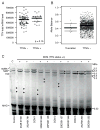Integrated allelic, transcriptional, and phenomic dissection of the cardiac effects of titin truncations in health and disease
- PMID: 25589632
- PMCID: PMC4560092
- DOI: 10.1126/scitranslmed.3010134
Integrated allelic, transcriptional, and phenomic dissection of the cardiac effects of titin truncations in health and disease
Abstract
The recent discovery of heterozygous human mutations that truncate full-length titin (TTN, an abundant structural, sensory, and signaling filament in muscle) as a common cause of end-stage dilated cardiomyopathy (DCM) promises new prospects for improving heart failure management. However, realization of this opportunity has been hindered by the burden of TTN-truncating variants (TTNtv) in the general population and uncertainty about their consequences in health or disease. To elucidate the effects of TTNtv, we coupled TTN gene sequencing with cardiac phenotyping in 5267 individuals across the spectrum of cardiac physiology and integrated these data with RNA and protein analyses of human heart tissues. We report diversity of TTN isoform expression in the heart, define the relative inclusion of TTN exons in different isoforms (using the TTN transcript annotations available at http://cardiodb.org/titin), and demonstrate that these data, coupled with the position of the TTNtv, provide a robust strategy to discriminate pathogenic from benign TTNtv. We show that TTNtv is the most common genetic cause of DCM in ambulant patients in the community, identify clinically important manifestations of TTNtv-positive DCM, and define the penetrance and outcomes of TTNtv in the general population. By integrating genetic, transcriptome, and protein analyses, we provide evidence for a length-dependent mechanism of disease. These data inform diagnostic criteria and management strategies for TTNtv-positive DCM patients and for TTNtv that are identified as incidental findings.
Copyright © 2015, American Association for the Advancement of Science.
Conflict of interest statement
Figures





Comment in
-
Tackling the achilles' heel of genetic testing.Sci Transl Med. 2015 Jan 14;7(270):270fs1. doi: 10.1126/scitranslmed.aaa4276. Sci Transl Med. 2015. PMID: 25589629
References
-
- Hershberger RE, Hedges DJ, Morales A. Dilated cardiomyopathy: the complexity of a diverse genetic architecture. Nature reviews Cardiology. 2013;10:531–547. - PubMed
-
- Ware JS, Roberts AM, Cook SA. Next generation sequencing for clinical diagnostics and personalised medicine: implications for the next generation cardiologist. Heart (British Cardiac Society) 2012;98:276–281. - PubMed
-
- Lakdawala NK, Funke BH, Baxter S, Cirino AL, Roberts AE, Judge DP, Johnson N, Mendelsohn NJ, Morel C, Care M, Chung WK, Jones C, Psychogios A, Duffy E, Rehm HL, White E, Seidman JG, Seidman CE, Ho CY. Genetic testing for dilated cardiomyopathy in clinical practice. Journal of cardiac failure. 2012;18:296–303. - PMC - PubMed
Publication types
MeSH terms
Substances
Associated data
Grants and funding
- N01WH42119/WH/WHI NIH HHS/United States
- N01 WH022110/WH/WHI NIH HHS/United States
- R01 HL080494/HL/NHLBI NIH HHS/United States
- N01WH32111/WH/WHI NIH HHS/United States
- SP/10/10/28431/BHF_/British Heart Foundation/United Kingdom
- 092854/Z/10/Z/WT_/Wellcome Trust/United Kingdom
- N01WH42124/WH/WHI NIH HHS/United States
- MC_U120085815/MRC_/Medical Research Council/United Kingdom
- N01WH32102/WH/WHI NIH HHS/United States
- N02-HL-6-4278/HL/NHLBI NIH HHS/United States
- 5-T32-GM007748-33/GM/NIGMS NIH HHS/United States
- N01-HC-25195/HC/NHLBI NIH HHS/United States
- N01 HC095172/HL/NHLBI NIH HHS/United States
- R01 NS017950/NS/NINDS NIH HHS/United States
- N01WH42112/WH/WHI NIH HHS/United States
- U54 HG003067/HG/NHGRI NIH HHS/United States
- N01WH32112/WH/WHI NIH HHS/United States
- N01WH32101/WH/WHI NIH HHS/United States
- N01WH32119/WH/WHI NIH HHS/United States
- N01WH32105/WH/WHI NIH HHS/United States
- N01WH42132/WH/WHI NIH HHS/United States
- FS/13/13/29819/BHF_/British Heart Foundation/United Kingdom
- N01WH42121/WH/WHI NIH HHS/United States
- N01WH42113/WH/WHI NIH HHS/United States
- N01WH42125/WH/WHI NIH HHS/United States
- N01WH32106/WH/WHI NIH HHS/United States
- N01WH42129/WH/WHI NIH HHS/United States
- T32 GM007753/GM/NIGMS NIH HHS/United States
- N01WH42108/WH/WHI NIH HHS/United States
- HL080494/HL/NHLBI NIH HHS/United States
- N01WH42118/WH/WHI NIH HHS/United States
- N01WH32113/WH/WHI NIH HHS/United States
- HL-102924/HL/NHLBI NIH HHS/United States
- N01WH42120/WH/WHI NIH HHS/United States
- N01WH32118/WH/WHI NIH HHS/United States
- N01WH42131/WH/WHI NIH HHS/United States
- RC2 HL102924/HL/NHLBI NIH HHS/United States
- N01WH42109/WH/WHI NIH HHS/United States
- 087183/Z/08/Z/WT_/Wellcome Trust/United Kingdom
- N01 HC025195/HL/NHLBI NIH HHS/United States
- N01WH42114/WH/WHI NIH HHS/United States
- N01WH32122/WH/WHI NIH HHS/United States
- N01WH42107/WH/WHI NIH HHS/United States
- HHMI/Howard Hughes Medical Institute/United States
- N01 HC095170/HL/NHLBI NIH HHS/United States
- N01WH42130/WH/WHI NIH HHS/United States
- N01WH42117/WH/WHI NIH HHS/United States
- N01WH42115/WH/WHI NIH HHS/United States
- ARC_/Arthritis Research UK/United Kingdom
- FS/15/29/31492/BHF_/British Heart Foundation/United Kingdom
- N01-HC-95171/HC/NHLBI NIH HHS/United States
- R01 HL084553/HL/NHLBI NIH HHS/United States
- N01WH44211/WH/WHI NIH HHS/United States
- 6R01-NS 17950/NS/NINDS NIH HHS/United States
- UC2 HL102924/HL/NHLBI NIH HHS/United States
- N01WH42111/WH/WHI NIH HHS/United States
- WT095908/WT_/Wellcome Trust/United Kingdom
- N01-HC-95172/HC/NHLBI NIH HHS/United States
- N01WH32109/WH/WHI NIH HHS/United States
- N01WH32108/WH/WHI NIH HHS/United States
- WT_/Wellcome Trust/United Kingdom
- N01WH42122/WH/WHI NIH HHS/United States
- N01WH32100/WH/WHI NIH HHS/United States
- N01 HC095171/HL/NHLBI NIH HHS/United States
- N01WH42123/WH/WHI NIH HHS/United States
- PG/12/27/29489/BHF_/British Heart Foundation/United Kingdom
- T32 GM007748/GM/NIGMS NIH HHS/United States
- N01WH32115/WH/WHI NIH HHS/United States
- N01-HC-95170/HC/NHLBI NIH HHS/United States
- N01WH24152/WH/WHI NIH HHS/United States
- N01WH42110/WH/WHI NIH HHS/United States
- N01WH42126/WH/WHI NIH HHS/United States
- N01WH42116/WH/WHI NIH HHS/United States
LinkOut - more resources
Full Text Sources
Other Literature Sources
Medical
Molecular Biology Databases

